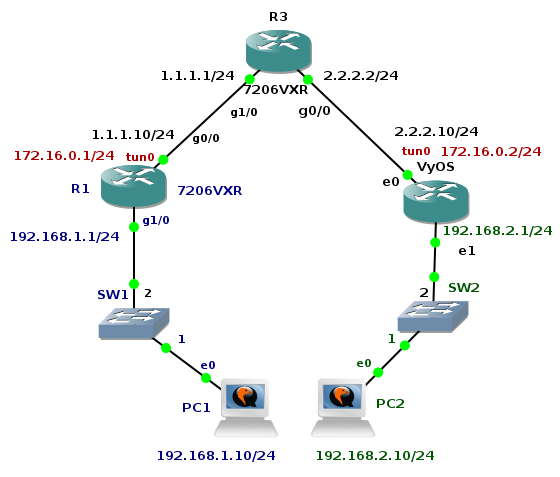GRE over IPSec Tunnel Between Cisco and VyOS
The previous tutorial shown GRE tunnel configuration between Cisco router and Linux Core. The big advantage of GRE protocol is that it encapsulates L3 and higher protocols inside the GRE tunnel so routing updates and other multicast traffic can be successfully transferred over the tunnel. The main drawback of GRE protocol is the lack of built-in security. Data are transferred in plain-text over the tunnel and peers are not authenticated (no confidentiality). Tunneled traffic can be changed by attacker (no integrity checking of IP packets). For this reason GRE tunnel is very often used in conjunction with IPSec. Typically, GRE tunnel is encapsulated inside the IPSec tunnel and this model is called GRE over IPSec.
The tutorial shows configuration of OSPF routing protocol, GRE and IPSec tunnel on Cisco 7206 VXR router and appliance running VyOS network OS. Devices are running inside GNS3 lab an they are emulated by Dynamips (Cisco) and Qemu (VyOS).
Picture 1 - Topology
Note: VyOS installation is described here. You can easily build your own VyOS Qemu appliance using the Expect and Bash script shared in the article.
1. R3 Configuration
R3(config)# interface gigabitEthernet 1/0
R3(config-if)# ip address 1.1.1.1 255.255.255.0
R3(config-if)# no shutdown
R3(config-if)# interface gigabitEthernet 0/0
R3(config-if)# ip Continue reading
Juniper NXTWork 2015
Coming this November, Juniper has finally jumped into the Customer Summit bandwagon. This is something that has been asked for for many years now, a way for Juniper customers and advocates to get together and talk Juniper. This event will allow you to connect with your peers in the industry, meet current and potential […]
The post Juniper NXTWork 2015 appeared first on Fryguy's Blog.
Manchester, UK: CloudFlare’s 63rd data center

Our new point of presence in Manchester, UK brings the CloudFlare network to 63 points of presence across 33 countries. In other words, the sun never sets across the CloudFlare network. Our data center in Manchester also admits the United Kingdom into a small club of countries with more than one CloudFlare data center, including the US, China, Japan, Australia, Germany, and France.
As of yesterday, traffic from the majority of Internet users in Northern England is now mere milliseconds away. More importantly, our Manchester and London data centers allow for redundancy and content localization within the UK for all of our customers.
In homage
The city of Manchester has made more than its fair share of technical contributions over the years. It is the city where Rolls met Royce (their first car drove off the line of their Manchester factory in 1904), and is also home to the first modern computer. The computer, nicknamed "Baby", was built at The University of Manchester using technology developed for WWII communications equipment, and ran the world's first stored program at 11am on Monday 21st June, 1948.

It is fitting, then, that in the last three years there has been a concerted effort Continue reading
NetCracker’s Virtual CPE Gets Tested by Etisalat
 The residential vCPE shows its prowess at provisioning Layer 2 services and firewalls.
The residential vCPE shows its prowess at provisioning Layer 2 services and firewalls.
Cisco CEO Weighs In On White Boxes, IoT, & Open Source
 Programmability and a 'fast, fast fast' approach will lead the digital revolution, Robbins says.
Programmability and a 'fast, fast fast' approach will lead the digital revolution, Robbins says.
Cumulus VX: Spine-Leaf Topology
In this post we will work on a Spine-Leaf topology shown in the official website of Cumulus VX We'll also close an open point fromRadisys FlowEngine Provides Intelligent Network Traffic Distribution
 This Radisys brief explains how FlowEngine enables providers to scale efficiently while offering increased service agility to achieve truly intelligent network traffic distribution.
This Radisys brief explains how FlowEngine enables providers to scale efficiently while offering increased service agility to achieve truly intelligent network traffic distribution.
Automation Testing: Tools and Concepts
Original Post Here By: Kristian Van Der Vliet One of the key tenets of DevOps is automation, or more specifically,Musing: Amazon stops selling competitor products, impact on AWS ?
If you build a service on the AWS cloud, are you at risk if Amazon decides to compete with you ?
The post Musing: Amazon stops selling competitor products, impact on AWS ? appeared first on EtherealMind.

